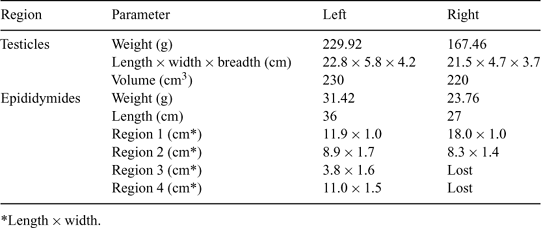223 DESCRIPTION OF GENITALIA AND SPERM RECOVERED POSTMORTEM FROM A PYGMY SPERM WHALE, KOGIA BREVICEPS
F. Martinez-Pastor A B , V. Garcia-Macias A , J. Garcia A , M. Alvarez A , E. Anel A , P. Herraez B , P. de Paz B and L. Anel AA Animal Reproduction, University of León, León, Spain
B Cell Biology, University of León, León, Spain
Reproduction, Fertility and Development 18(2) 219-220 https://doi.org/10.1071/RDv18n2Ab223
Published: 14 December 2005
Abstract
A pygmy sperm whale (Kogia breviceps; adult male; 350 kg) was stranded and died on a beach near Cabo Bustos (Asturias, North of Spain) on March 12th, 2005. Finding specimens of this species is a rare event on Spanish shores, although this whale is not considered endangered. Postmortem examination was performed 24 h later. Genitalia (testicles and epididymides) were extracted. The postmortem report indicated that vas deferens and seminal glands seemed to contain an important amount of semen, which was not recovered. Refrigerated genitalia were send to our laboratory, arriving around 40 h postmortem. The refrigerated testicles were in poor physical condition upon arrival, indicating advanced tissue detoriation. The epididymides (very long) were not closely attached to the testicles, but were connected by a loose conjunctive membrane. We divided the epididymides into four regions that approximated the (1) caput, (2) mid-region, (3) corpus, and (4) cauda. Physical characteristics of the genitalia are described in Table 1. The left testicle was larger, and possibly more active, than the right one. A sperm sample was obtained from the cauda region after incising the tissue. Osmolality and pH of the sample were 428 mOsm/kg and 6.62, respectively (maybe due to tissue breakdown) and the sperm concentration was 1194 × 106/mL. Spermatozoa were immotile, even after diluting in buffered medium; it is possible that postmortem damage occurred quickly. However, using flow cytometry we determined that 57% of cauda spermatozoa had intact plasma membranes and acrosomes (determined by staining with 37 mmol/mL propidium iodide and 1 μg/mL PNA-FITC; Sigma, Madrid, Spain). Examination by phase contrast microscopy (×600) showed many spermatozoa with abnormal heads and bent midpieces and flagella, even in the cauda (13% and 21%, respectively). Sperm head morphometry was studied using DiffQuick staining and an automated analysis system (SCA2000; Microptic, Barcelona, Spain). Mean sperm head size was 3.71 ± 0.19 × 2.61 ± 0.12 μm in width and length, respectively. Computer analysis (AnalySiS-GmbH, Cologne, Germany) of phase contrast images revealed that the mean size of the sperm midpiece and flagellum were 3.44 ± 0.19 and 40.95 ± 2.02 μm, respectively. The information obtained after postmortem recovery of the testes and epididymis should be useful to future conservation efforts of the pygmy sperm whale and similar species. The rapid deterioration of the testicular tissue by 40 h postmortem was not expected since good quality sperm samples have been obtained at similar postmortem intervals in other species. Therefore, we recommend that postmortem sperm recovery should be accomplished as rapidly as possible in this species.

|


